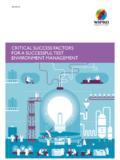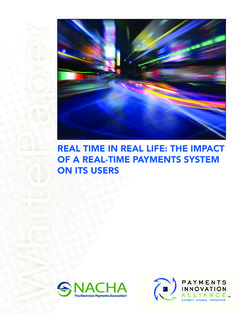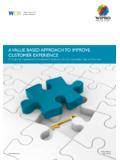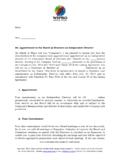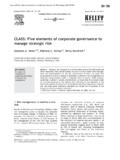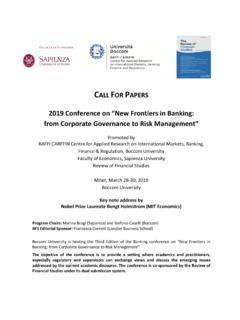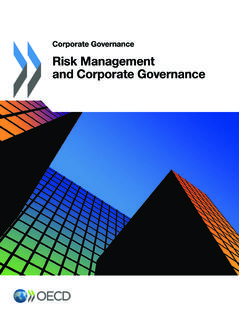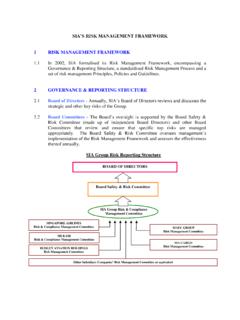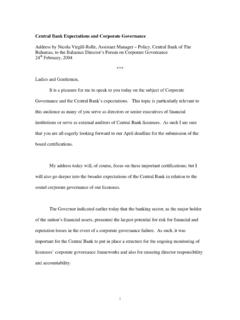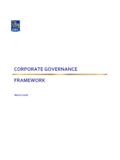Transcription of Enterprise Risk Management for Banks - Wipro
1 1 | Enterprise Risk Management for BanksWIPRO TECHNOLOGIES Enterprise RISK Management FOR Banks Wipro TECHNOLOGIESS eshagiri Rao Vaidyula, Senior Manager, Governance, Risk and Compliance Jayaprakash Kavala, Consultant, Banking and Financial Services 2 | Enterprise Risk Management for BanksWIPRO TECHNOLOGIES 1. INTRODUCTION ..3 2. RECENT FINANCIAL CRISIS AND WHAT WENT 3. INITIATING AND IMPLEMENTING Enterprise RISK Management ..6 4. CHALLENGES IN ADOPTING Enterprise RISK Management ..7 5. Wipro S APPROACH TO Enterprise RISK Management ..9 6. CONCLUSION ..11 TABLE OF CONTENTS 3 | Enterprise Risk Management for BanksWIPRO TECHNOLOGIES1. INTRODUCTION Risk Management in banking sector is in limelight especially after the recent turbulence that has impacted the very existence of banking sector as a viable industry. The journey of risk Management started way back in early 1800 s, where the Banks had recognized the significance of the role of risk Management and had adapted the same by creating a risk function in their organizations.
2 Not only the bank s, even the various government bodies have recognized the repercussions / impact of not managing the risks effectively in Banks and accordingly enacted several regulations to control risks that arise in the banking business and operations. From there onwards, the risk function in the Banks has evolved over a period of time and reached to a stage where the need felt to have a common criteria to measure & quantify the risks so that a comparative analysis of the Banks can be performed and made available to the stakeholders. This development has lead to introduction of BASEL Norms by BIS Committee. The committee has guided all the central Banks of the participating countries and the Banks governed by them to adapt and align their risk Management practices to the norms over a period in time. The Basel norms are focused on the risks in Operational, Credit and Market areas which in turn helped the Banks to quantify the risks and standardize their risk Management practices in the said areas.
3 However, most of the Banks have seen Basel norms as another mundane exercise of regulatory compliance instead of a tool for effective risk Management which has resulted in reality as a pure eye wash act to satisfy the regulatory authorities. The situation resulted was mainly on account of Banks being under constant scrutiny of the regulatory authorities and cornered with multiple number of regulations to be complied with. In other words, Banks in their efforts to comply with these multi regulations realized that complying with all the mandatory regulations is too cumbersome because many times the data and approach required to meet different requirements are quite similar resulting in duplicated efforts and increased costs. One way, these multi regulations have jeopardized the very essence of the regulations and risk Management itself. Moreover, given the depth n breadth and geographical spread of the banking business and operations, Banks realized that Basel norms are not comprehensive enough to establish a comprehensive risk Management system which could help them to identify, mitigate risks across Enterprise in all the areas and at the same time rationalize and mature their risk Management practices across the Enterprise .
4 The above said factors lead to a scenario where the Banks started looking beyond Regulatory compliance and Basel norms for an Enterprise wide approach to cater to all risk requirements in more cost effective and efficient manner. Banks have identified and started adapting the Enterprise Risk Management Framework released by COSO (Committee of Sponsoring Organizations of the Treadway Commission) as a framework to drive their initiatives in risk Management beyond Basel norms and regulatory compliances. The COSO ERM framework has all the components that could help the Banks to stand a chance to derive business value while meeting compliance requirements. The ERM Framework is structured around eight key components and four key objectives of business viz. strategic, operations, reporting and 4 | Enterprise Risk Management for BanksWIPRO TECHNOLOGIES compliance. The components of the ERM Framework are given below: Enterprise Risk Management enables the organizations to pragmatically deal with uncertainty and associated risk and opportunity thus enhancing the brand value and profitability.
5 Enterprise risk Management helps in identifying and selecting among alternative risk responses risk avoidance, reduction, transfer, and acceptance. It helps to ensure effective reporting and compliance with laws and regulations, and avoid damage to the entity s reputation and associated consequences. To summarize, Enterprise Risk Management helps an entity get to where it wants to go and avoid pitfalls and surprises along the way. An organization has to understand the challenges, various risk domains and risk areas relevant to the business and the different kinds of ERM activities which need to be carried out to successfully implement ERM application. Establishes the entity s risk culture Sets the Enterprise Risk objectives Identifies events that affect entity s objectives Assesses risks based on likelihood and impact Evaluates possible responses to risks Establishes policies, procedures and controls Enables information exchange Evaluates effectiveness of the ERM Program 5 | Enterprise Risk Management for BanksWIPRO TECHNOLOGIES2.
6 RECENT FINANCIAL CRISIS AND WHAT WENT WRONG The Banks worldwide should take a cue from the recent battering that many of the financial services companies have faced in the last 12 months. Although the Banks have already adopted and implemented Basel II norms and established Enterprise risk Management programs, most of them were unsuccessful in understanding how the market forces have influenced their Risk Appetite and their risk Management systems were not robust enough to identify and report on how the risk culture is being influenced by the internal and external forces. For instance, Banks and other investors continued to purchase newer types of investments without having the proper infrastructure in place to identify and manage the risks . This is a classic example of trading risk mismanagement. More over, In reality,, the risk Management function is always seen as a non contributing asset, which is in place to meet the some regulatory requirements.
7 This had lead to underestimating the role of risk Management in the growth and sustenance of an organization which resulted in a secondary role of risk function and consideration of risks in decision making. It is obvious that in most of the Banks the business gets priority over risks , and decisions were made by overlooking the controls to mitigate the risks (in other words, an eye wash exercise). The learning that comes out of this episode is that the risk Management practices have to be more rigorously & seriously followed and the banking industry should put up the necessary resources to constantly improve on the guidelines. 6 | Enterprise Risk Management for BanksWIPRO TECHNOLOGIES3. INITIATING AND IMPLEMENTING Enterprise RISK Management Globally Banks are realizing that they need a more pragmatic approach for managing a growing plethora of risks enveloping the banking and financial industries landscape and have now understood the significance of ERM to sustain their organization.
8 ERM can be defined as a process that enables Banks to effectively deal with varied types of risks and opportunities, thus increasing the stakeholder value. In addition to that what makes ERM so compelling is that, it expresses risk not just as a threat, but also as an opportunity. ERM enables the Banks to move away from the silo approach to risk Management ( different internal groups responsible for each type of risk) and move towards the holistic view of Enterprise wide risks . ERM helps the organizations to eliminate the duplicates and , redundancies in risks & related control procedures that exist mainly because of different groups define same risk differently, implement different control procedures and use different analytical models based on different assumptions and underlying data sets. A first step towards initiation of ERM program in the organization starts with understanding the risk appetite, setting tone for risk governance and planting & nourishing the risk culture across the entity.
9 Among the others, also it includes: Creating a standardized, Enterprise wide risk framework views of risk, including common definitions, assumptions and analytics. Setting risk objectives and ensuring that they are aligned to corporate objectives, risk appetite and culture Ensuring risk Management remains independent of business lines. This includes changing reporting lines so risk Management functions report directly to the Board of Directors rather than the CEO. CEOs and other senior executives are typically rewarded for short term gains in the institution s performance, and this creates an incentive to maximize short term gains, even if it increases the institution s long term risk exposure. Expanding internal model governance groups responsible for the independent review and validation of risk models. The next step is to identify the Risk Domains , Risk Areas to define the boundaries of Risk Management function in the Enterprise .
10 Once the boundaries are set, the focus will move to identify the threats & vulnerabilities and creating a risk profile for each risk area in particular and for organization as a whole. Then the journey of ERM will move towards identifying and selecting strategies for mitigation of risks (includes establishing controls) and setting up a system of continuous monitoring and managing risk profile. Before embarking on the ERM path, the Banks should clearly identify and understand the strategy and business objectives. Banks should also have a broad outline of various types of risk being faced by the organization and recognize that ERM is not a quick process but a long and arduous journey. The data and the results which come out of the ERM should be used to improve the holistic ERM practice and thus it is more of an iterative approach rather than a one time process. Strategically, ERM can be viewed as key component of corporate governance framework. 7 | Enterprise Risk Management for BanksWIPRO TECHNOLOGIES4.


